Topic 1 :OUTCOMES OF FRANCE VISIT

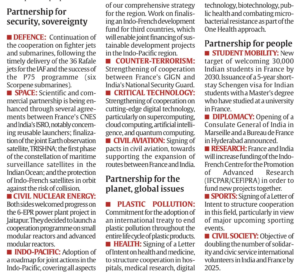
Grand Cross of the Legion of Honour
- PM Modi received the Grand Cross of the Legion of Honour France’s highest civilian and military honour, from President Emmanuel Macron at the Elysee Palace on July 13, 2023.
- PM Modi became the first Indian PM to receive this honour, joining the ranks of other prominent world leaders such as Nelson Mandela, Angela Merkel, Boutros Boutros-Ghali, etc⁴.
Bastille Day Parade
- PM Modi witnessed the French Bastille Day parade as the Guest of Honour on July 14, 2023.
- A triservice contingent of 400 Indian personnel participated in the parade, along with a marching band from the Punjab Regiment.
- The parade commemorated the 25th anniversary of the India-France strategic partnership.
Strategic Convergence
- PM Modi held wide-ranging talks with President Macron on various issues of bilateral and global importance, such as nuclear energy, defence cooperation, civil nuclear issues, space, cyber security,counter terrorism,climate change,renewable energy, and the international solar alliance.
- PM Modi and President Macron agreed to advance their collaboration in nuclear energy, especially in the field of small modular reactors and fusion reactors.
- PM Modi said that France was a key partner for India’s Make in India and Aatmanirbhar Bharat initiatives, and that they were preparing a roadmap for the next 25 years of their strategic partnership.
- PM Modi also expressed India’s readiness to contribute to the restoration of peace and stability in Ukraine, and welcomed France’s support for India’s permanent membership in the UN Security Council.
Cultural Exchange
- PM Modi met prominent personalities in Paris, including 100-year-old Yoga enthusiast Charlotte Chopin and CEO of Chanel Leena Nair.
- He held discussions with Nair on ways to further boost skill development among artisans and to promote Indian handicrafts in France.
Key Deals
- Gaganyaan Mission
- India and France signed an agreement for the cooperation on Gaganyaan Mission, India’s first manned space mission.
- France’s space agency, CNES, will support scientific experiment plans and will provide French equipment, consumables, and medical instruments for Indian astronauts’ use.
Rafale Jets and Submarines

- India and France are likely to sign big-ticket defence deals, especially in the field of maritime military plans, involving 26 new Rafale-M fighter jets that will fit into India’s maritime military plans.
- The two sides are also expected to sign a contract for the construction of three Scorpene submarines for the Indian Navy, adding to the six already being built in India under a technology transfer agreement.
- UPI Service
PM Modi inaugurated the UPI service in France from the Eiffel Tower, marking a new milestone in digital payments between the two countries.
Topic 2 : WPI INFLATION
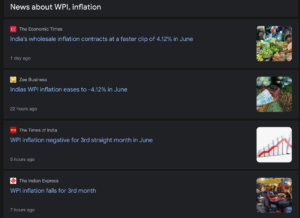
What is WPI inflation?
- WPI inflation stands for Wholesale Price Index inflation.
- It is a measure of the change in the prices of goods sold and traded in bulk by wholesale businesses to other businesses.
- It reflects the average price movement of goods at the first stage of transactions, before they reach the retail level.
- WPI inflation is calculated by the Office of the Economic Adviser, Department for Promotion of Industry and Internal Trade (DPIIT), based on the monthly data collected from various sources such as oil companies, manufacturing units, and institutional sources.
The base year for WPI inflation is 2011-12, which means the prices of goods in that year are taken as 100 and the changes in prices are expressed as percentage points over that base.
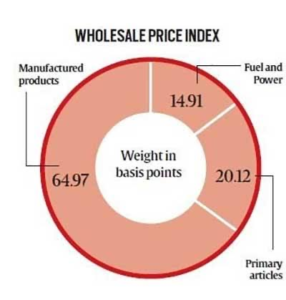
- WPI inflation is composed of three major groups:
- Primary Articles, Fuel and Power, and Manufactured Products.
Each group has a different weight in the overall WPI index, reflecting its relative importance in the economy.
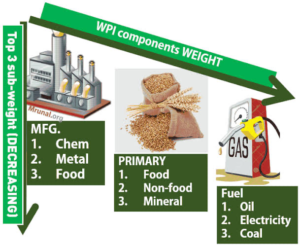
Image Source : Mrunal.org
- The weights are based on the value of output at factor cost (excluding indirect taxes) for each group.
What are the trends and causes of WPI inflation in India?
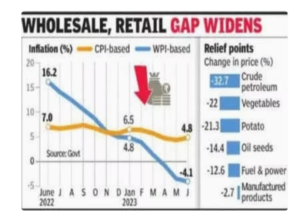
- Food Index is a derived indicator based on Food Articles from Primary Articles group and Food Products from Manufactured Products group.
- WPI inflation has declined from November to January in all major groups except Primary Articles which increased slightly in January due to higher prices of minerals and non-food articles.
The main factors that contributed to the decline in WPI inflation are:
- Decline in prices of mineral oils such as petrol, diesel, kerosene etc., due to easing of global crude oil prices amid lower demand and higher supply.
- Decline in prices of chemicals and chemical products such as fertilizers, pesticides etc., due to lower input costs and improved availability.
- Decline in prices of textiles and textile products such as cotton, yarn, fabrics etc., due to lower demand and higher production.
- Decline in prices of crude petroleum and natural gas, due to lower global prices and higher domestic production.
- Decline in prices of food products such as sugar, edible oils, dairy products etc., due to higher supply and lower demand.
What are the implications and challenges of WPI inflation in India?
- WPI inflation has both positive and negative implications for the economy and society.
- WPI inflation reflects the cost of production for the producers and sellers of goods.
- A lower WPI inflation means lower input costs and higher profit margins for them, which can boost their investment and output.
- A higher WPI inflation means higher input costs and lower profit margins for them, which can reduce their investment and output.
- WPI inflation also affects the consumers of goods, especially those who buy goods at wholesale level such as traders, retailers, exporters etc.
- A lower WPI inflation means lower wholesale prices and higher purchasing power for them, which can increase their demand and sales.
- A higher WPI inflation means higher wholesale prices and lower purchasing power for them, which can decrease their demand and sales.
- WPI inflation also influences the CPI inflation, which captures the change in the prices of goods and services consumed by households.
- A lower WPI inflation means lower cost of production and lower pass-through of wholesale prices to retail prices, which can reduce the CPI inflation and increase the real income and welfare of households.
- A higher WPI inflation means higher cost of production and higher pass-through of wholesale prices to retail prices, which can increase the CPI inflation and decrease the real income and welfare of households.
- WPI inflation also affects the macroeconomic stability and policy making in the country.
- A lower WPI inflation means lower inflationary expectations and pressures, which can create a conducive environment for economic growth and development.
- A higher WPI inflation means higher inflationary expectations and pressures, which can create a challenging environment for economic growth and development.
Some of the challenges that WPI inflation poses are:
- Measuring and monitoring WPI inflation accurately and timely, given the diversity and complexity of goods sold and traded in bulk in the country.
- Balancing the trade-offs between WPI inflation and other macroeconomic objectives such as growth, employment, fiscal deficit, current account deficit etc.
- Managing the supply-side shocks that affect WPI inflation such as fluctuations in global commodity prices, weather conditions, geopolitical events etc.
Coordinating the monetary policy (interest rates) and fiscal policy (taxes and spending) to achieve an optimal level of WPI inflation that is consistent with the potential output and welfare of the economy.
Source:
(1) Annual rate of inflation based on all India Wholesale Price Index (WPI …. https://www.pib.gov.in/PressReleaseIframePage.aspx?PRID=1899048.
Topic 3: Competition Commission of India
Introduction
- Competition Commission of India (CCI) is the chief national competition regulator in India.
- It is a statutory body within the Ministry of Corporate Affairs and is responsible for enforcing the Competition Act, 2002 to promote competition and prevent activities that have an appreciable adverse effect on competition in India
– Role and Mandate
– Ensuring fair trade practices
– Promoting healthy competition in the market
– Preventing anti-competitive agreements and abuse of dominance
– Regulating mergers and acquisitions for market stability
– Protecting consumer interests and choices
Key Achievements
– Curbing anti-competitive practices
– Promoting level playing field for businesses
– Encouraging innovation and efficiency
– Enhancing consumer welfare
– Boosting investor confidence
Impact on Economy
– Fostering economic growth and development
– Encouraging entrepreneurship and innovation
– Reducing market distortions and inefficiencies
– Creating a competitive business environment
– Stimulating foreign investments
Enforcement Mechanisms
– Investigating and penalizing anti-competitive behavior
– Conducting market studies for better regulatory insights
– Advocating competition-friendly policies and reforms
– Collaborating with international counterparts
Consumer Empowerment
– Educating consumers about their rights
– Resolving consumer complaints and grievances
– Promoting price transparency and fair practices
– Ensuring access to quality goods and services
– Safeguarding consumer choice and competition
Recent works of CCI
- In the Microsoft case, the CCI ordered Microsoft to modify its licensing agreements to allow Indian consumers to install software on more than one computer. This order has helped to reduce the cost of software for Indian consumers.
- In the Coca-Cola case, the CCI ordered Coca-Cola to stop using exclusive arrangements with retailers. This order has helped to increase competition in the soft drinks market in India.
- The Tata-Airtel case, the CCI ordered Tata-Airtel to pay compensation to consumers who were overcharged for their mobile phone services.
Future Challenges and Initiatives
– Addressing digital monopolies and platform dominance eg. recent Google case).
– Nurturing competition in emerging sectors
– Strengthening international cooperation and harmonization
– Promoting inclusive and sustainable growth
GEAC
What is GEAC?
- GEAC stands for Genetic Engineering Appraisal Committee.
- It is the apex biotech regulatory body in India.
- It is a statutory body under the Ministry of Environment, Forest and Climate Change (MoEF&CC).
- Constituted under EPA,1986
History of GEAC
- GEAC was formed as the Genetic Engineering Approval Committee in 1990.
- It was renamed to Genetic Engineering Appraisal Committee in 2012.
- It was the first body to approve the commercial cultivation of Bt cotton in India in 2002.
Functions of GEAC
● It is responsible for appraisal of activities involving large scale use of hazardous microorganisms and recombinants in research and industrial production from the environmental angle.
● It is also responsible for appraisal of proposals relating to release of genetically engineered (GE) organisms and products into the environment including experimental field trials.
● It is chaired by the Special Secretary/Additional Secretary of MoEF&CC and co-chaired by a representative from the Department of Biotechnology (DBT).
● It has 24 members and meets every month to review the applications in the areas indicated above.
Mandate of GEAC
- GEAC is mandated to regulate the use, manufacture, storage, import and export of hazardous microorganisms or genetically-engineered organisms and cells in India.
- GEAC is also mandated to implement the provisions of the Cartagena Protocol on Biosafety, which is an international agreement on biosafety as a supplement to the Convention on Biological Diversity.
- GEAC is also mandated to ensure that all activities involving the use of genetically modified organisms are carried out in accordance with the Guidelines for Safety Assessment of Foods Derived from Genetically Engineered Plants, which were issued by the Indian Council of Medical Research in 20083.
Challenges faced by GEAC
Regulatory hurdles
- Lack of clarity and coordination among different ministries and agencies involved in biosafety regulation
- Opposition from various stakeholders such as farmers, consumers, civil society groups, and state governments
- Legal challenges and court cases filed by anti-GMO activists and NGOs
- Inadequate public awareness and communication about the benefits and risks of GM crops
- Influence of international conventions and protocols on biosafety such as the Cartagena Protocol and the Nagoya Protocol.
Scientific challenges
- Lack of sufficient data and studies on the long-term environmental and health impacts of GM crops.
- Lack of standardized protocols and guidelines for conducting field trials, biosafety tests, and risk assessments.
- Lack of adequate infrastructure and human resources for conducting research and monitoring of GM crops.
- Lack of access to independent and peer-reviewed scientific information and expertise on GM crops.
Successful regulation by GEAC
- Approval of Bt cotton
- GEAC approved the commercial cultivation of Bt cotton, India’s first transgenic food crop, in 2002.
- Bt cotton is a genetically modified variety of cotton that expresses a toxin from the bacterium Bacillus thuringiensis (Bt) that kills certain insect pests such as bollworms.
- Bt cotton has been widely adopted by Indian farmers and has contributed to increased yields, reduced pesticide use, and improved incomes.
- Approval of recombinant pharma products
- GEAC has also approved several recombinant pharma products derived from genetically engineered microorganisms or cells for import, manufacture, or use in India.
- Some of these products include insulin,human growth hormone,follicle-stimulating hormone, human albumin,monoclonal antibodies, antihemophilic factors, and vaccines.
- These products have enhanced the availability and affordability of life-saving drugs and vaccines for various diseases and disorders.
- Implementation of biosafety guidelines
- GEAC has also implemented various biosafety guidelines and protocols for the safe handling and use of genetically engineered organisms and products in India.
- Some of these guidelines include:
- Guidelines for Safety Assessment of Foods Derived from Genetically Engineered Plants (2008)
- Guidelines for the Environmental Risk Assessment of Genetically Engineered Plants (2016)
- Guidelines for the Conduct of Confined Field Trials of Regulated, Genetically Engineered Plants in India (2008)
- Standard Operating Procedures for Detection of Living Modified Organisms (2018).
- These guidelines have ensured that the potential risks of genetically engineered organisms and products are assessed and managed in a scientific and transparent manner.

